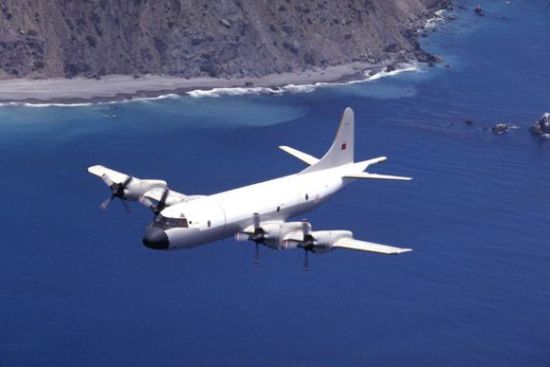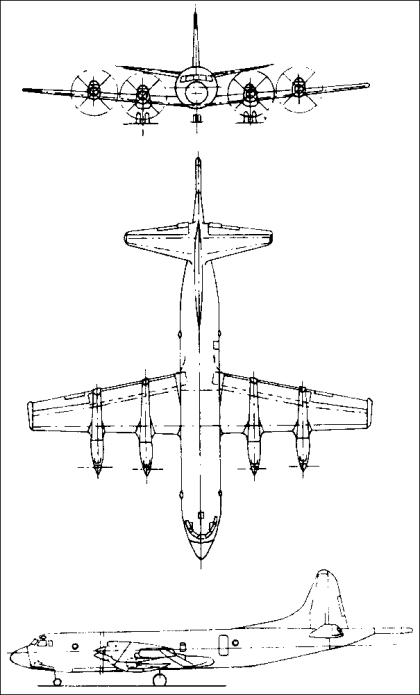|
||||||||||
|
|
||||||||||
|
||||||||||
|
|
||||||||||
 - -
|
|

|
Lockheed P-3 Orion Maritime Patrol/ Anti-Submarine Plane |
|
DESCRIPTION:
The P-3 was developed as a land-based anti-submarine maritime patrol aircraft to replace the US Navy's aging P2V Neptune. Also known as the Orion, the P-3 was derived from the Lockheed L-188 Electra passenger airliner. Externally, the only significant differences between the Electra and the P-3 are inclusion of an unpressurized weapons bay forward of the wing, a shortened fuselage, and addition of a magnetic anomaly detector (MAD) boom at the tail. The P-3 maintains excellent short-takeoff performance for such a large aircraft as well as good handling, even with three of its four engines inoperative. The original P-3A and P-3B aircraft were built in large numbers during the 1960s, but few remain in service today. The P-3C, incorporating continually improved electronics, continues to serve after having gone through no less than five major updates. The current fleet is armed with a variety of sensors for detecting and locating enemy submarines and ships, torpedoes, mines, depth charges, and Harpoon anti-ship missiles. In recent years, older P-3 airframes have also been adapted to a variety of other tasks, inculding the P-3AEW&C airborne radar platform used by US Customs to combat drug trafficing and the EP-3E Aries intelligence aircraft used to monitor communications and electronic emissions. The Orion has proven very popular with foreign nations and has been operated by at least 18 navies and air forces. The US Navy plans to phase out its remaining P-3 fleet in favor of the P-8 Poseidon, and foreign operators are rapidly upgrading their fleets with the retired American planes or replacing them with a variety of smaller turboprops or regional jets.
Data below for P-3C |
|
| HISTORY: | |
| First Flight |
(YP3V) 19 August 1958 (YP-3A) 25 November 1959 (P-3A) 15 April 1961 (P-3C) 18 September 1968 (P-3C Update III) August 1983 |
|
Service Entry
|
(P-3A) August 1962 (P-3C) 1969 |
| CREW: |
three to five flight crew: pilot, co-pilot, and flight engineer plus an optional relief pilot and flight
engineer six tactical crew: tactical control officer, navigation/communication officer, three sensor station operators, ordnanceman maximum accomodation: 21 |
|
ESTIMATED COST:
|
$36 million
|
| AIRFOIL SECTIONS: | |
| Wing Root | NACA 0014-1.10 |
|
Wing Tip
|
NACA 0012-1.10
|
| DIMENSIONS: | |
| Length | 116.83 ft (35.61 m) |
| Wingspan | 99.67 ft (30.37 m) |
| Height | 33.71 ft (10.27 m) |
| Wing Area | 1,300 ft² (120.77 m²) |
|
Canard Area
|
not applicable
|
| WEIGHTS: | |
| Empty | 61,490 lb (27,890 kg) |
| Normal Takeoff | 135,000 lb (61,235 kg) |
| Max Takeoff | 142,000 lb (64,410 kg) |
| Fuel Capacity |
internal: unknown external: unknown |
|
Max Payload
|
20,000 lb (9,072 kg)
|
| PROPULSION: | |
| Powerplant | four Allison T56-14 turboprops |
| Thrust |
19,640 eshp (14,644 kW)
|
| PERFORMANCE: | |
| Max Level Speed |
at altitude: 475 mph (760 km/h) at 15,000 ft (4,570 m) at sea level: unknown patrol speed: 235 mph (380 km/h) |
| Initial Climb Rate | 1,950 ft (595 m) / min |
| Service Ceiling | 28,300 ft (8,625 m) |
| Range |
typical: 2,700 nm (4,990 km) [3 hr loiter] ferry: 4,165 nm (7,705 km) |
| g-Limits |
unknown
|
| ARMAMENT: | |
| Gun | none |
| Stations | 1 internal weapons bay and 10 external hardpoints |
| Air-to-Air Missile | none |
| Air-to-Surface Missile | AGM-84 Harpoon |
| Bomb | various free-fall |
| Other |
up to one 2,000 lb (910 kg) sea mine or up to three 1,000 lb (455 kg) sea mines, up to eight nuclear or
conventional depth charges, up to eight ASW torpedoes, rockets, cameras, nd up to 87 sonobuoys
|
| KNOWN VARIANTS: | |
| YP3V | Prototype |
| P-3A | Production anti-submarine warfare (ASW) maritime patrol model; 157 built |
| P-3A (CS) | Modified P-3A airframes with improved radar for use by the US Customs Service; 4 modified |
| CP-3A | Older P-3A airframes rebuilt as cargo transports; 30 modified |
| EP-3A | Electronic reconnaissance model rebuilt from P-3A airframes |
| NP-3A | Special test aircraft used by the US Naval Research Laboratory |
| RP-3A | Ocean reconaissance model rebuilt from P-3A airframes, used by the Oceanographic Development Squadron; 3 modified |
| TP-3A | Trainer based on the P-3A; 12 modified |
| UP-3A | Utility transport |
| VP-3A | VIP/staff transports rebuilt from P-3A or WP-3A airframes; 5 modified |
| WP-3A | Weather reconnaissance model based on the P-3A; 4 modified |
| P-3B | ASW maritime patrol model with more powerful engines and able to carry AGM-12 Bullpup missiles; 125 built |
| EP-3B | Electronic reconnaissance model rebuilt from older P-3B airframes |
| NP-3B | Special test aircraft used by the US Naval Research Laboratory |
| P-3C | ASW maritime patrol model with upgraded electronics including a new central computer to process data, camera pods, and FLIR pods; 267 built |
| P-3C Update I | P-3C with upgraded computer memory and an improved navigation system; 31 built |
| P-3C Update II | P-3C updated with infrared detection equipment, sonobuoys, and the ability to launch Harpoon anti-ship missiles; 44 built |
| P-3C Update II.5 | P-3C with better navigation and communication equipment; 24 built |
| P-3C Update III | P-3C updated with an acoustic processing system, a new sonobuoy receiver, and other improved avionics; 50 built |
| P-3C Update IV | All Update II and II.5 aircraft equipped with a new radar and other submarine detection equipment |
| EP-3C | Electronic intelligence model built by Kawasaki for the Japanese Navy |
| NP-3C | Special test aircraft used by the US Naval Research Laboratory |
| RP-3C | Science models used by the Oceanographic Development Squadron |
| UP-3C | Utility transport |
| RP-3D | P-3C modified to collect atmospheric data; 1 modified |
| WP-3D | P-3C airframes converted for use by the National Oceanographic and Atmospheric Administration (NOAA) as weather reconnaissance platforms; 2 modified |
| EP-3E Aries | Rebuilt P-3 aircraft equipped with a radome and antennae for detecting and locating enemy ships; 12 modified |
| EP-3E Aries II | Rebuilt P-3C aircraft equipped with a radome and antennae for detecting and locating enemy ships or gathering signals intelligence; 12 modified |
| NP-3E | US Navy test aircraft |
| P-3F | Version of the P-3C built for Iran in the late 1970s; 6 built |
| P-3G | Original designation for the Lockheed P-7 intended to replace the P-3 but cancelled in 1990 |
| P-3H | Proposed upgraded variant of the P-3C |
| P-3K | Version for New Zealand based on the P-3B; 6 built |
| P-3K2 | Program to upgrade New Zealand's P-3K fleet with new sensors |
| P-3N | Version for the Norwegian Coast Guard based on the P-3B; 2 built |
| P-3P | Version used by Portugal based on the P-3B; 6 transferred from Australia |
| P-3W | Version based on the P-3C-II for the Australian Air Force; 20 built |
| P-3AEW&C | P-3B aircraft equipped with a rotating radome used by the US Customs Service for anti-drug trafficing patrols |
| CP-140 Aurora | Rebuilt P-3C airframes used by Canada; 18 modified |
|
CP-140A Arcturus
|
CP-140 aircraft modified for environmental and fishery patrol; 3 modified
|
| KNOWN COMBAT RECORD: |
Bosnia - Operation Deliberate Force (USN, 1995) Afghanistan - Operation Enduring Freedom (USN, 2001-2002) Libya - Operation Unified Protector / Odyssey Dawn (Canada, USN [P-3C, EP-3E], 2011) |
| KNOWN OPERATORS: |
Argentina, Comando de Aviación Naval Argentina (Argentine Naval Aviation) Australia (Royal Australian Air Force) Brazil, Força Aérea Brasileira (Brazilian Air Force) Canada (Canadian Armed Forces, Air Command) Chile, Armada de Chile (Chilean Navy) Germany, Deutsche Marineflieger (German Naval Air Arm) Greece, Elliniki Polimiki Naftikon (Hellenic Navy) Iran (Imperial Iranian Air Force) Iran (Islamic Republic of Iran Air Force) Japan, Kaijo Jieitai (Japan Maritime Self Defence Force) Netherlands, Koninklijke Luchmacht (Royal Netherlands Air Force) New Zealand (Royal New Zealand Air Force) Norway, Kongelige Norske Luftforsvaret (Royal Norwegian Air Force) Pakistan (Pakistani Navy Aviation Force) Portugal, Força Aérea Portuguesa (Portuguese Air Force) South Korea, Dae-han-min-guk Hae-gun (Republic of Korea Navy) Spain, Ejército del Aire Española (Spanish Air Force) Taiwan (Republic of China Navy) United States (US Navy) |
|
3-VIEW SCHEMATIC:

|
|
SOURCES:
|
|


|
Aircraft | Design | Ask Us | Shop | Search |

|
|
| About Us | Contact Us | Copyright © 1997-2023 | |||
|
|
|||